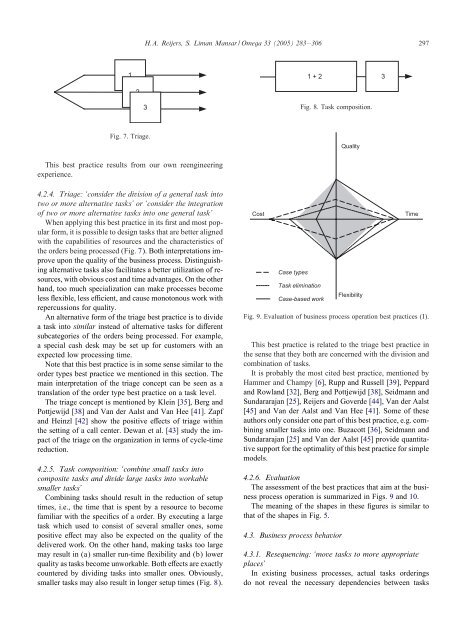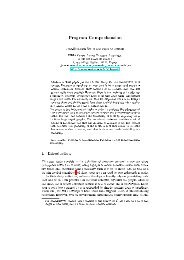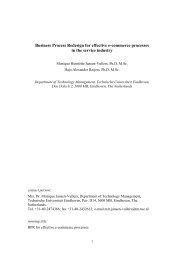Best practices in business process redesign: an overview and ...
Best practices in business process redesign: an overview and ...
Best practices in business process redesign: an overview and ...
Create successful ePaper yourself
Turn your PDF publications into a flip-book with our unique Google optimized e-Paper software.
1<br />
2<br />
H.A. Reijers, S. Lim<strong>an</strong> M<strong>an</strong>sar / Omega 33 (2005) 283 – 306 297<br />
3<br />
Fig. 7. Triage.<br />
This best practice results from our own reeng<strong>in</strong>eer<strong>in</strong>g<br />
experience.<br />
4.2.4. Triage: ‘consider the division of a general task <strong>in</strong>to<br />
two or more alternative tasks’ or ‘consider the <strong>in</strong>tegration<br />
of two or more alternative tasks <strong>in</strong>to one general task’<br />
When apply<strong>in</strong>g this best practice <strong>in</strong> its rst <strong>an</strong>d most popular<br />
form, it is possible to design tasks that are better aligned<br />
with the capabilities of resources <strong>an</strong>d the characteristics of<br />
the orders be<strong>in</strong>g <strong>process</strong>ed (Fig. 7). Both <strong>in</strong>terpretations improve<br />
upon the quality of the bus<strong>in</strong>ess <strong>process</strong>. Dist<strong>in</strong>guish<strong>in</strong>g<br />
alternative tasks also facilitates a better utilization of resources,<br />
with obvious cost <strong>an</strong>d time adv<strong>an</strong>tages. On the other<br />
h<strong>an</strong>d, too much specialization c<strong>an</strong> make <strong>process</strong>es become<br />
less exible, less e cient, <strong>an</strong>d cause monotonous work with<br />
repercussions for quality.<br />
An alternative form of the triage best practice is to divide<br />
a task <strong>in</strong>to similar <strong>in</strong>stead of alternative tasks for di erent<br />
subcategories of the orders be<strong>in</strong>g <strong>process</strong>ed. For example,<br />
a special cash desk may be set up for customers with <strong>an</strong><br />
expected low <strong>process</strong><strong>in</strong>g time.<br />
Note that this best practice is <strong>in</strong> some sense similar to the<br />
order types best practice we mentioned <strong>in</strong> this section. The<br />
ma<strong>in</strong> <strong>in</strong>terpretation of the triage concept c<strong>an</strong> be seen as a<br />
tr<strong>an</strong>slation of the order type best practice on a task level.<br />
The triage concept is mentioned by Kle<strong>in</strong> [35], Berg <strong>an</strong>d<br />
Pottjewijd [38] <strong>an</strong>d V<strong>an</strong> der Aalst <strong>an</strong>d V<strong>an</strong> Hee [41]. Zapf<br />
<strong>an</strong>d He<strong>in</strong>zl [42] show the positive e ects of triage with<strong>in</strong><br />
the sett<strong>in</strong>g of a call center. Dew<strong>an</strong> et al. [43] study the impact<br />
of the triage on the org<strong>an</strong>ization <strong>in</strong> terms of cycle-time<br />
reduction.<br />
4.2.5. Task composition: ‘comb<strong>in</strong>e small tasks <strong>in</strong>to<br />
composite tasks <strong>an</strong>d divide large tasks <strong>in</strong>to workable<br />
smaller tasks’<br />
Comb<strong>in</strong><strong>in</strong>g tasks should result <strong>in</strong> the reduction of setup<br />
times, i.e., the time that is spent by a resource to become<br />
familiar with the speci cs of a order. By execut<strong>in</strong>g a large<br />
task which used to consist of several smaller ones, some<br />
positive e ect may also be expected on the quality of the<br />
delivered work. On the other h<strong>an</strong>d, mak<strong>in</strong>g tasks too large<br />
may result <strong>in</strong> (a) smaller run-time exibility <strong>an</strong>d (b) lower<br />
quality as tasks become unworkable. Both e ects are exactly<br />
countered by divid<strong>in</strong>g tasks <strong>in</strong>to smaller ones. Obviously,<br />
smaller tasks may also result <strong>in</strong> longer setup times (Fig. 8).<br />
Cost<br />
Case types<br />
Task elim<strong>in</strong>ation<br />
1 + 2 3<br />
Fig. 8. Task composition.<br />
Case-based work<br />
Quality<br />
Flexibility<br />
Time<br />
Fig. 9. Evaluation of bus<strong>in</strong>ess <strong>process</strong> operation best <strong>practices</strong> (I).<br />
This best practice is related to the triage best practice <strong>in</strong><br />
the sense that they both are concerned with the division <strong>an</strong>d<br />
comb<strong>in</strong>ation of tasks.<br />
It is probably the most cited best practice, mentioned by<br />
Hammer <strong>an</strong>d Champy [6], Rupp <strong>an</strong>d Russell [39], Peppard<br />
<strong>an</strong>d Rowl<strong>an</strong>d [32], Berg <strong>an</strong>d Pottjewijd [38], Seidm<strong>an</strong>n <strong>an</strong>d<br />
Sundararaj<strong>an</strong> [25], Reijers <strong>an</strong>d Goverde [44], V<strong>an</strong> der Aalst<br />
[45] <strong>an</strong>d V<strong>an</strong> der Aalst <strong>an</strong>d V<strong>an</strong> Hee [41]. Some of these<br />
authors only consider one part of this best practice, e.g. comb<strong>in</strong><strong>in</strong>g<br />
smaller tasks <strong>in</strong>to one. Buzacott [36], Seidm<strong>an</strong>n <strong>an</strong>d<br />
Sundararaj<strong>an</strong> [25] <strong>an</strong>d V<strong>an</strong> der Aalst [45] provide qu<strong>an</strong>titative<br />
support for the optimality of this best practice for simple<br />
models.<br />
4.2.6. Evaluation<br />
The assessment of the best <strong>practices</strong> that aim at the bus<strong>in</strong>ess<br />
<strong>process</strong> operation is summarized <strong>in</strong> Figs. 9 <strong>an</strong>d 10.<br />
The me<strong>an</strong><strong>in</strong>g of the shapes <strong>in</strong> these gures is similar to<br />
that of the shapes <strong>in</strong> Fig. 5.<br />
4.3. Bus<strong>in</strong>ess <strong>process</strong> behavior<br />
4.3.1. Resequenc<strong>in</strong>g: ‘move tasks to more appropriate<br />
places’<br />
In exist<strong>in</strong>g bus<strong>in</strong>ess <strong>process</strong>es, actual tasks order<strong>in</strong>gs<br />
do not reveal the necessary dependencies between tasks






